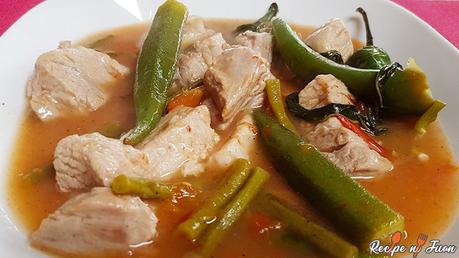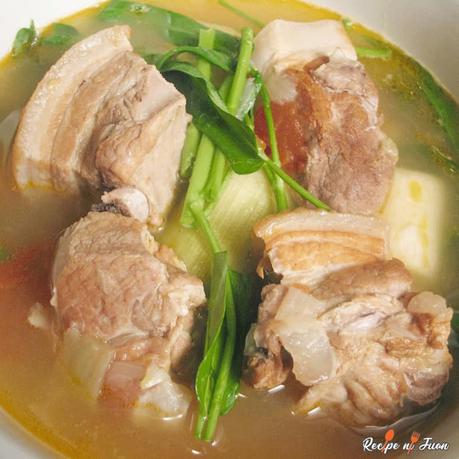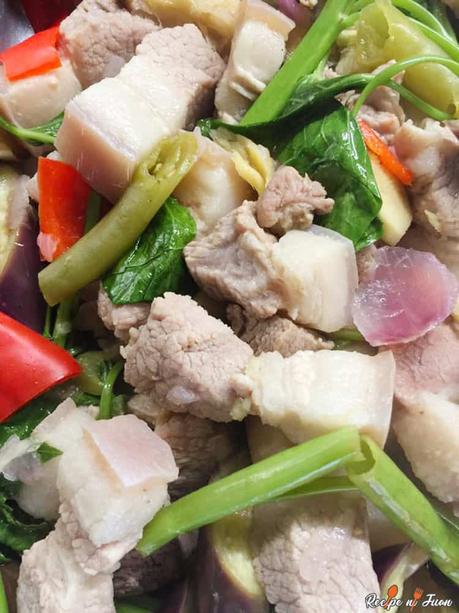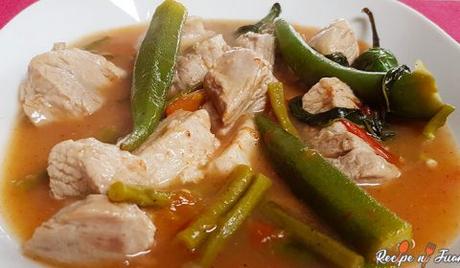“Why Sinigang?” asks Doreen Fernandez, a well-known food historian.
In her essay, “Why Sinigang?” she argues that sinigang is the national dish of the Philippines and proceeds to her essay defending the case of sinigang.
Sinigang, actually, is the other half of the debate as to which one really is the national dish of the Philippines.
And with Sinigang’s flexibility when it comes to its ingredients, its adaptability to the different tastes of the Filipinos, it’s being a comfort food during the rainy season and its brothy and homey goodness, you can never deny that the case of sinigang is just too strong.
With this Sinigang na Baboy recipe, we will be introduced to the many incarnations of this beloved dish.

Sinigang na Baboy Recipe and Preparation
Pork Sinigang or Sinigang na Baboy is a sour, brothy dish in the Philippines, it is usually cooked with pork “buto-buto” or other meat parts of pork.
Its sourness, on the other hand, can be achieved by almost any fruit or vegetable that is sour depending on where you are in the Philippines.
The ingredients for this Pork Sinigang recipe typically includes Sampalok as used as a souring agent.
However, there are other variants in which Santol, Bayabas, Kamias, or Mangoes are used.

To save time, though, you can also use a store-bought sinigang mix as the souring agent.
Other ingredients also include radish, for it to give sinigang its very distinct taste that enhances the taste of the souring agent, tomatoes, kangkong, okra, and green chili (which is optional if you want it spicy).
To prepare sinigang, sauté garlic and onions in a pot and wait for it to be translucent, add the pork and water and let it simmer for 4-5 minutes.
Then you can add the souring agent.
If you are using tamarind, put the tamarinds in a large strainer and using the water from the pot, grind the tamarind with a fork until all of its juices are squeezed out.
For the other souring agents like sliced bayabas, kamias, santol or mangoes, this is the time that you put it in the pot and let it simmer again for another 5 minutes or until the pork and the souring agents are already tender.
The last items that you put in are the okra or kangkong. In this part, you can already turn off the stove and let the remaining heat cook these vegetables.

Serve this pork sinigang with rice and fish sauce on the side or during rainy days, you can eat it with dried fish.
With its homey broth and its heating effect during the rainy seasons and cooling effect during summer, this pork sinigang recipe is going to be a very flexible dish anytime or in any season.

Sinigang na Baboy recipe
Serve this pork sinigang with rice and fish sauce on the side or during rainy days, you can eat it with dried fish. Course Main CourseCuisine FilipinoKeyword Pork Prep Time 20 minutesCook Time 45 minutesTotal Time 1 hour 5 minutes Servings 5 people Author Joost Nusselder Cost $8Ingredients
- 60 ml (2 fl oz/¼ cup) vegetable oil
- 500 g (1 lb 2 oz) American-style pork ribs cut into individual ribs
- 500 g (1 lb 2 oz) skinless boneless pork belly cut into 4 cm (1½ inch) pieces
- 1 large onion cut into wedges
- 3 vine-ripened tomatoes cut into wedges
- 1 small red capsicum (pepper) seeded and cut into wedges
- 100 g (3½ oz) tamarind pulp (see note)
- 250 ml (8½ fl oz/1 cup) boiling water
- 4 cm (1½ inch) piece horseradish peeled and cut into thirds
- 1 Japanese eggplant (aubergine) cut into 3 cm (1¼ inch) slices on the diagonal
- 200 g (7 oz) snake (sitaw) or green beans trimmed, tied into knots if desired
- 2 tsp salt flakes
- thinly sliced spring onions (scallions), steamed rice, fish sauce, and kalamansi or lemon wedges, to serve
Instructions
- Heat 2 tsp of the vegetable oil in a large, deep saucepan over medium-high heat. Cook the pork ribs for 4 minutes, turning until browned on both sides. Transfer to a plate once cooked. Add another 2 tsp of oil to the pan and cook the pork belly for 4 minutes, turning until browned. Set aside with the ribs.
- Add the remaining vegetable oil to the pan and heat over medium heat. Add the onion and cook, stirring and scraping any bits from the base of the pan, for 2 minutes. Add the tomato and capsicum, and cook, stirring occasionally, for a further 4 minutes, or until starting to soften. Return the pork to the pan with 1.5 liters (51 fl oz/6 cups) water. Bring to the boil, then reduce the heat to low–medium and cook for 15 minutes.
- Meanwhile, place the tamarind pulp in a heatproof bowl and cover with the boiling water. Leave to stand for 15 minutes to soften, then mash to combine well (I use my hands). Strain through a sieve into a bowl, pushing the seeds to extract their liquid. Discard the solids.
- Add the tamarind mixture to the pan and cook for 5 minutes. Add the horseradish and eggplant, and cook for 5 minutes, or until the eggplant is almost tender. Add the beans and cook for a further 3 minutes, or until the vegetables and meat are tender. Add the salt and season with freshly cracked black pepper; the soup should be a balance of sour and salty. Transfer to a large serving bowl and scatter with spring onions. Serve with steamed rice, fish sauce, and kalamansi.
Aside from this Pork Sinigang Recipe, You can also try making your own sinigang, Please Visit Our Beef Sinigang sa Kamias Recipe and also, the Sinigang na Bangus sa Bayabas Recipe.
Thank You, and MABUHAY!!
